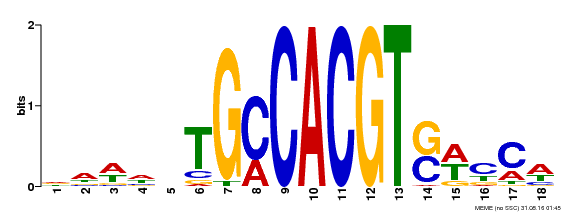 |
PlantRegMap/PlantTFDB v5.0
Plant Transcription
Factor Database
|
| Home TFext BLAST Prediction Download Help About Links PlantRegMap |
Transcription Factor Information
| Basic Information? help Back to Top | |||||||||
|---|---|---|---|---|---|---|---|---|---|
| TF ID | GSBRNA2T00095159001 | ||||||||
| Common Name | GSBRNA2T00095159001 | ||||||||
| Organism | |||||||||
| Taxonomic ID | |||||||||
| Taxonomic Lineage |
cellular organisms; Eukaryota; Viridiplantae; Streptophyta; Streptophytina; Embryophyta; Tracheophyta; Euphyllophyta; Spermatophyta; Magnoliophyta; Mesangiospermae; eudicotyledons; Gunneridae; Pentapetalae; rosids; malvids; Brassicales; Brassicaceae; Brassiceae; Brassica
|
||||||||
| Family | bZIP | ||||||||
| Protein Properties | Length: 336aa MW: 36020.6 Da PI: 9.842 | ||||||||
| Description | bZIP family protein | ||||||||
| Gene Model |
|
||||||||
| Signature Domain? help Back to Top | |||||||
|---|---|---|---|---|---|---|---|
| No. | Domain | Score | E-value | Start | End | HMM Start | HMM End |
| 1 | bZIP_1 | 46.9 | 6.1e-15 | 258 | 313 | 5 | 60 |
CHHHCHHHHHHHHHHHHHHHHHHHHHHHHHHHHHHHHHHHHHHHHHHHHHHHHHHH CS
bZIP_1 5 krerrkqkNReAArrsRqRKkaeieeLeekvkeLeaeNkaLkkeleelkkevaklk 60
+r+rr++kNRe+A rsR+RK+a++ eLe +v++L++eN++L+ + ++ ++ ++ +
GSBRNA2T00095159001 258 RRQRRMIKNRESAARSRARKQAYTVELEAEVAKLKEENEELQRKQAKIMEMQKNQE 313
79***************************************999888888876655 PP
| |||||||
| Protein Features ? help Back to Top | ||||||
|---|---|---|---|---|---|---|
| Database | Entry ID | E-value | Start | End | InterPro ID | Description |
| SMART | SM00338 | 3.8E-13 | 254 | 318 | IPR004827 | Basic-leucine zipper domain |
| PROSITE profile | PS50217 | 11.243 | 256 | 307 | IPR004827 | Basic-leucine zipper domain |
| Gene3D | G3DSA:1.20.5.170 | 2.3E-14 | 258 | 307 | No hit | No description |
| Pfam | PF00170 | 8.2E-13 | 258 | 314 | IPR004827 | Basic-leucine zipper domain |
| CDD | cd14707 | 2.17E-26 | 258 | 312 | No hit | No description |
| SuperFamily | SSF57959 | 4.75E-11 | 258 | 307 | No hit | No description |
| PROSITE pattern | PS00036 | 0 | 261 | 276 | IPR004827 | Basic-leucine zipper domain |
| Gene Ontology ? help Back to Top | ||||||
|---|---|---|---|---|---|---|
| GO Term | GO Category | GO Description | ||||
| GO:0009414 | Biological Process | response to water deprivation | ||||
| GO:0009651 | Biological Process | response to salt stress | ||||
| GO:0009738 | Biological Process | abscisic acid-activated signaling pathway | ||||
| GO:0010255 | Biological Process | glucose mediated signaling pathway | ||||
| GO:0045893 | Biological Process | positive regulation of transcription, DNA-templated | ||||
| GO:0005634 | Cellular Component | nucleus | ||||
| GO:0000976 | Molecular Function | transcription regulatory region sequence-specific DNA binding | ||||
| GO:0003700 | Molecular Function | transcription factor activity, sequence-specific DNA binding | ||||
| Sequence ? help Back to Top |
|---|
| Protein Sequence Length: 336 aa Download sequence Send to blast |
MKCMILVTSS GSRSNMNFKN NNNNMGNEPP GDGSGGAALT RQGSIYSLTF DEFQSSLGKD 60 FGSMNMDELL KNIWTAEETQ AMAVAASTSG VIPLAGGGQE GLPLQRQGSL TLPRTLSTKT 120 VDQVWKDLSK DGGGGTNLTQ SQRQQTLGEV TLEEFLVRAG VVREEAQIAA KDANTGFSVQ 180 ASPQVVPGLM GNLGAETSLN MGLVQGVVGA AVSPVTPVSA DGIGKNNGDS SSLSPSPYMF 240 NGGVRGRKSG TVEKVVERRQ RRMIKNRESA ARSRARKQAY TVELEAEVAK LKEENEELQR 300 KQAKIMEMQK NQEMEMMNIQ GGAKKRLRRT ESGPW* |
| Expression -- Description ? help Back to Top | ||||||
|---|---|---|---|---|---|---|
| Source | Description | |||||
| Uniprot | TISSUE SPECIFICITY: Highly expressed in leaves. {ECO:0000269|PubMed:18931143}. | |||||
| Functional Description ? help Back to Top | ||||||
|---|---|---|---|---|---|---|
| Source | Description | |||||
| UniProt | Transcriptional activator that mediates abscisic acid (ABA) signaling (PubMed:18931143, PubMed:19947981, PubMed:27424498, PubMed:27325665). Can regulate the expression of a wide spectrum of stress-related genes in response to abiotic stresses through an ABA-dependent regulation pathway. Confers ABA-dependent drought and salinity tolerance (PubMed:18931143, PubMed:27325665). Binds specifically to the ABA-responsive elements (ABRE) in the promoter of target genes to mediate stress-responsive ABA signaling (PubMed:27325665, PubMed:27424498). {ECO:0000269|PubMed:18931143, ECO:0000269|PubMed:19947981, ECO:0000269|PubMed:27325665, ECO:0000269|PubMed:27424498}. | |||||
| Binding Motif ? help Back to Top | |||
|---|---|---|---|
| Motif ID | Method | Source | Motif file |
| MP00186 | DAP | Transfer from AT1G45249 | Download |

| |||
| Cis-element ? help Back to Top | |
|---|---|
| Source | Link |
| PlantRegMap | GSBRNA2T00095159001 |
| Regulation -- Description ? help Back to Top | ||||||
|---|---|---|---|---|---|---|
| Source | Description | |||||
| UniProt | INDUCTION: Induced by abscisic acid (ABA) (PubMed:18315698, PubMed:18931143). Induced by drought, salt and osmotic stresses (PubMed:18931143). {ECO:0000269|PubMed:18315698, ECO:0000269|PubMed:18931143}. | |||||
| Regulation -- PlantRegMap ? help Back to Top | ||||||
|---|---|---|---|---|---|---|
| Source | Upstream Regulator | Target Gene | ||||
| PlantRegMap | Retrieve | Retrieve | ||||
| Annotation -- Nucleotide ? help Back to Top | ||||||
|---|---|---|---|---|---|---|
| Source | Hit ID | E-value | Description | |||
| GenBank | HE616526 | 0.0 | HE616526.1 Brassica napus abf2 gene for abscisic acid responsive elements-binding factor 2, exons 1-4. | |||
| Annotation -- Protein ? help Back to Top | |||||||
|---|---|---|---|---|---|---|---|
| Source | Hit ID | E-value | Description | ||||
| Refseq | XP_022561047.1 | 0.0 | ABSCISIC ACID-INSENSITIVE 5-like protein 5 isoform X1 | ||||
| Swissprot | Q6Z312 | 2e-94 | BZP23_ORYSJ; bZIP transcription factor 23 | ||||
| TrEMBL | A0A078FVJ7 | 0.0 | A0A078FVJ7_BRANA; BnaC06g00420D protein | ||||
| STRING | Bo6g006970.1 | 0.0 | (Brassica oleracea) | ||||
| Orthologous Group ? help Back to Top | |||
|---|---|---|---|
| Lineage | Orthologous Group ID | Taxa Number | Gene Number |
| Malvids | OGEM734 | 27 | 129 |
| Best hit in Arabidopsis thaliana ? help Back to Top | ||||||
|---|---|---|---|---|---|---|
| Hit ID | E-value | Description | ||||
| AT1G45249.2 | 1e-74 | abscisic acid responsive elements-binding factor 2 | ||||



